Why begin with Ouma Gaas?
No particular reason at all. When working on my family tree, there was a huge gap above my mother’s paternal grandmother, as no one seemed to know who her parents were and where she had come from. I had traced back hundreds of years on other branches, but here was a huge blank space. So I was determined to get to the bottom of it, as was Uncle Mark Gillman, who had himself done a great deal of family research previously and knows more of the family and its history than anyone. So this is the story of just that search, trying hard not to get into too many diversions. Between Mark and me, we have mapped out the entire family going back many generations, but this is just about our search for a missing link.
Ouma Gaas was a mysterious figure on the periphery of our English speaking Cape Town family. She was the 2nd wife of my mother’s grandfather William John Gillman. She had left my great grandfather early on in the marriage, at a time when divorce was rare and frowned on, and some fragments of the shame of this early divorce hung about. Her grandchildren knew her in a limited way: when they were children she lived on the farm Groot Gaas a few hours away near Kamieskroon in Namaqualand, and would visit her son Charles and his family on their farm near Springbok. For most of her grandchildren’s young adult life in the late 1950’s and 1960’s Ouma Gaas was a relatively distant figure living with a new husband far up north, while they had returned to Cape Town (though she did visit her daughter, my Great Aunt Gladys at times), and when she came to Cape Town in the 1970’s, she was largely bedridden. My memory of her is as a large and slightly scary old Afrikaans lady in her 90’s lying in her high single bed in a dark back bedroom at her daughter Gladys’ home in Cape Town, where I would be told to go in and stand on tip toe to give her a kiss.
Ouma Sannie was born before birth registration was required in the Cape, and as she died with no estate, there was no death notice. Neither Mark nor I have been able to trace ANY paperwork from family sources. Uncle Mark had employed a researcher to trace documents in the Cape Archives more than a decade ago, and knew that she had remarried in 1922, and that she might have had another daughter before that.
In the last decade, internet research resources and genealogy research websites have grown exponentially. So it didn’t take long to begin finding references to her. In fact the first bit of information revealed two new husbands, and confirmed her full maiden name – Susanna Johanna van Wyk – and her birth, 7 August 1887. Before long her second husband’s will turned up and their Cape Town address, a few doors down the same street in Observatory that my mother moved to 20-odd years ago!
But still no clue as to her origins, apart from the farm Gaas.
So I started the other way round. It was standard practice amongst Afrikaner families at the time to name children after their parents and/or grandparents, and my one great uncle (Ouma Gaas’s 3rd son) had the unusual specific combination of Abraham Erasmus, and this name cropped up again in a grandchild. Another great uncle was named Josef, so a family with this combination would be a good start. I started sifting through ALL Abraham Erasmus van Wyk’s – and unsurprisingly they were (more or less) all from the Kamieskroon area of Namaqualand near Gaas. It wasn’t hard to find the van Wyk’s from the farm Koets, next door to Gaas. And there was Abraham Erasmus Johannes Cornelis van Wyk (and his son Abraham Erasmus Johannes Cornelis van Wyk …. With an uncle Josef Jacobus … and a few other Abraham Erasmuses in the near vicinity for good measure.)
The name seems to have started with this AEJC’s grandfather, Abraham Erasmus van Wyk, whose parents both descended from a pair of Smit sisters, Gezina and Marta (ie his two grandmothers were sisters). Their father was Erasmus Schmidt, so this AE seems to be named after his two grandmothers’ father. The first appearance of a van Wijk “Abraham” seems to be in honour of Abraham Vivier, this first Abraham van Wijk’s maternal grandfather, and was then passed down the eldest in that branch. This was our Abraham Erasmus’s great great grandfather, so seems too far back to be the immediate source – so possibly a later cousin in that branch of the tree was being honoured or remembered.
On an interesting side-note, Gezina Smit married Wilhelm Botha, whose grandfather was Schalk Willem van der Merwe (also an ancestor in the de Villiers branch of our family), and whether in fact or in wishful-thinking mythology, one can trace his ancestors on-line back to King Alfred of Wessex (Alfred the Great) and to Charlemagne!
My DNA tests also showed that the descendants of these van Wyks are approximately my 4th cousins. So we were definitely in the right zone.
None of them were recorded as having a daughter named Susanna van Wyk on any of the existing online family trees. But this just means no-one had yet added her and I knew no other descendants had been searching for her and recording her genealogy. So her absence wasn’t necessarily meaningful. The next step was a process of elimination- find those where she definitely was not a relative using the documentation I was able to find.
The main contender immediately hit the dust, as his Death Notice of 1911 is available scanned and indexed on-line. This lists all the deceased person’s children – and he had many – but no Susanna Johanna. But he did die on his farm Grootchaas! So here was an early link to the farm we knew as Groot Gaas – the trail was warming.
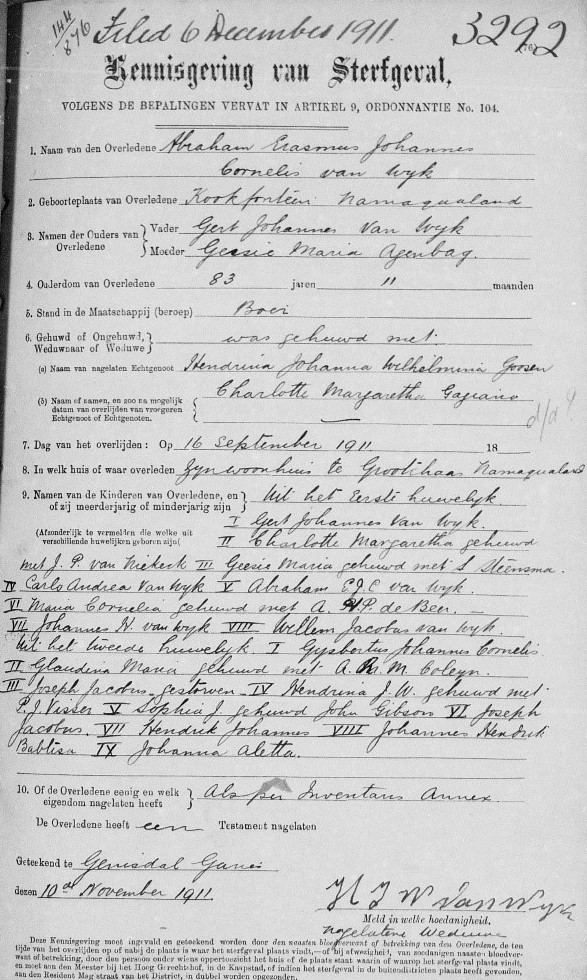
The uncle Josef was too young to be the father. Uncle Mark had identified his son, AEJC Jnr as a likely contender. He was having children at the right time, and various of his descendants had filled out online family trees indicating over a dozen children. But no sign of Sannie, and frustratingly no Death Notice available to confirm his children.
Uncle Mark and I trawled the on-line sources for clues, and I also meanwhile immersed myself in the history of the area, the farms, the families, cemeteries and topography. And then came the chance to join uncle Mark on a trip he had planned to Namaqualand – for him to revisit old familiar sights, and for me to see the family farms for the first time. And for both of us the chance hopefully to find out more!
Unexpectedly, the search for Sannie had thrown up the previously unknown fact that my great grandfather William John had been married before – to another van Wyk. So the Gillman connection to the farms Gaas and Koets and the van Wyks actually starts with the tragic story of Helena.
Helena Maria Gloudina van Wyk
I found Helena through her gravestone, a photograph of which turned up on-line. Helena Maria Gloudina was born in 1884, the daughter of Charlotte (Tollie) van Wyk, the 2nd wife of Gerrit van Wyk who owned the farm Koets.
In 1903 Helena married William John Gillman in the NG church in the little settlement of Bowesdorp.
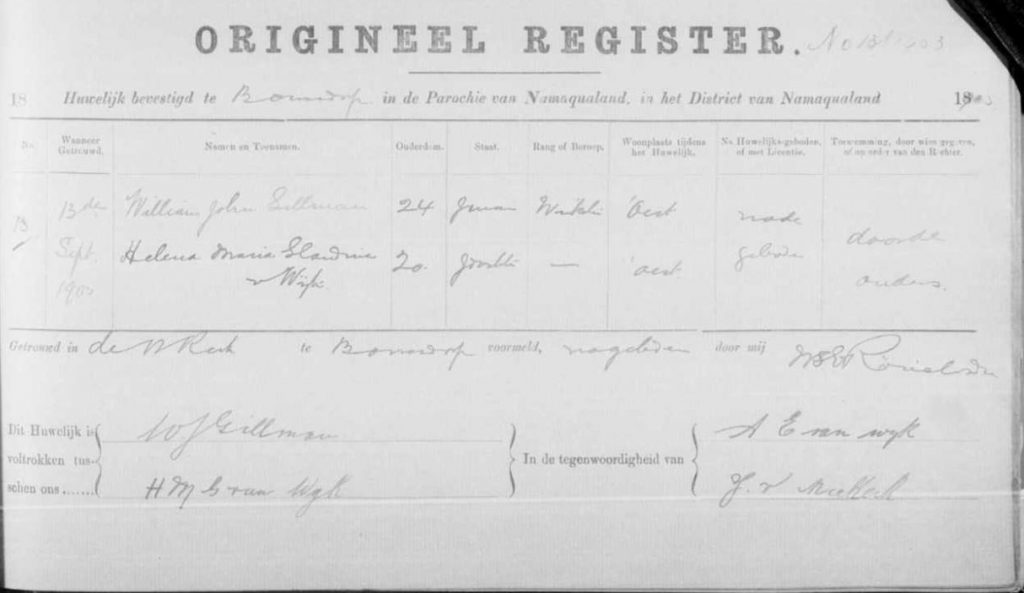
He was a shopkeeper (“Winkelier”) in Nababeep (a mining town just north of Springbok) and they went off together to live there, and she died just 5 months and 7 days later of TB.
Her mother Tollie and William’s mother Annie Gillman remained friends for life – I found Annie witnessing Tollie’s will 25 years later. And subsequesntly I discovered Annie’s mother was a cousin of Tollie’s mother: everyone in Namaqualand in the 19th C seemed to be related.
Thanks to Mark’s sleuthing we visited the grave in the old van Wyk farm cemetery hidden under a tree alongside a koppie just outside Kamieskroon, where she lies with her parents and siblings.
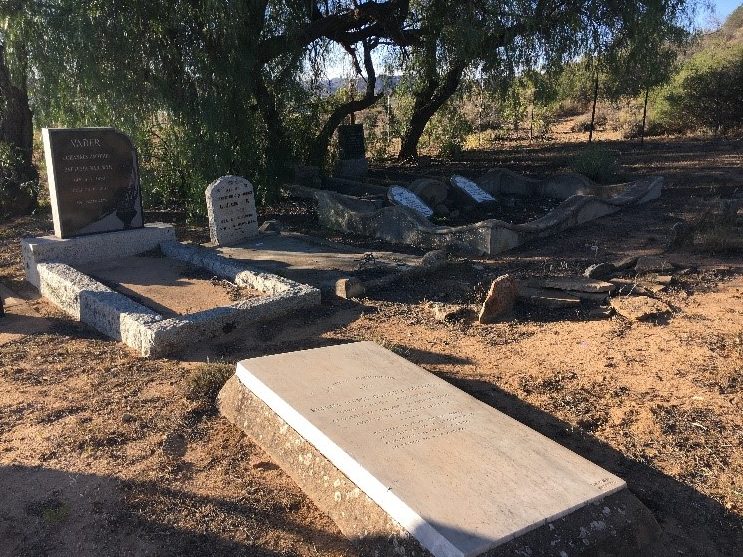
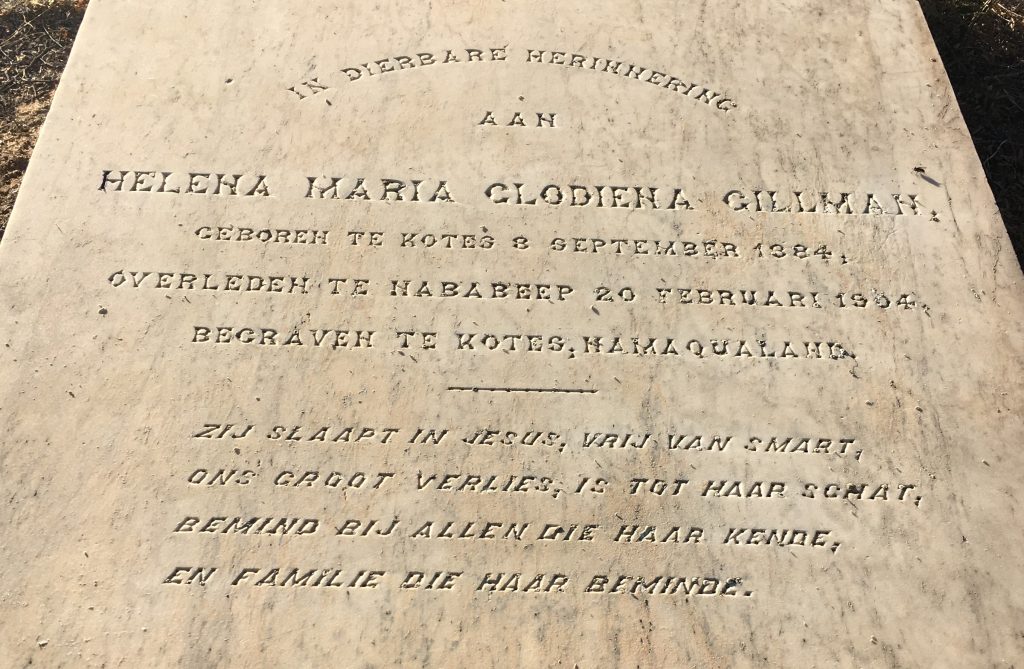
For us a great loss, for her a reward (treasure)
Beloved by all who knew her
And the family who loved her
Koets and Groot Gaas
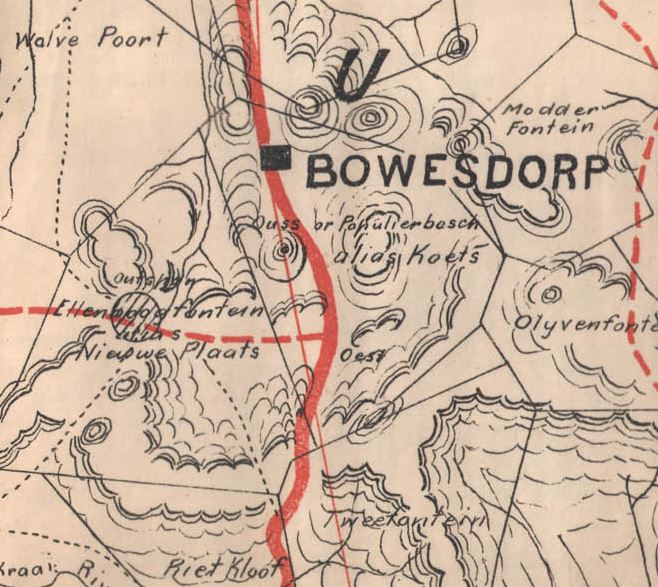
The farm variously known as ‘Ouss, Oess, Oest or Koets (also known as Populiersbosch), was granted to Gert Johannes van Wyk (1805 – 1857) in 1844. He divided it amongst his 5 children. The name begins with a Nama “click” sound that was first written as an apostrophe (‘) before Oess (‘Oess) and later became a K.
Abraham Erasmus Johannes Cornelis, the eldest son, took Groot Gaas (Grootchaas) which on the map above is situated about where the words “bosch” of Populiersbosch and “Koets” are written under the name “Bowesdorp”. This was the portion with the largest arable section of “lande”, the best water source (“Ga-as” is Nama for “agter fontein” and the spring is set right back in the valley under the Sneeuberg) … though perhaps the stunning view from the house would not have been relevant then!
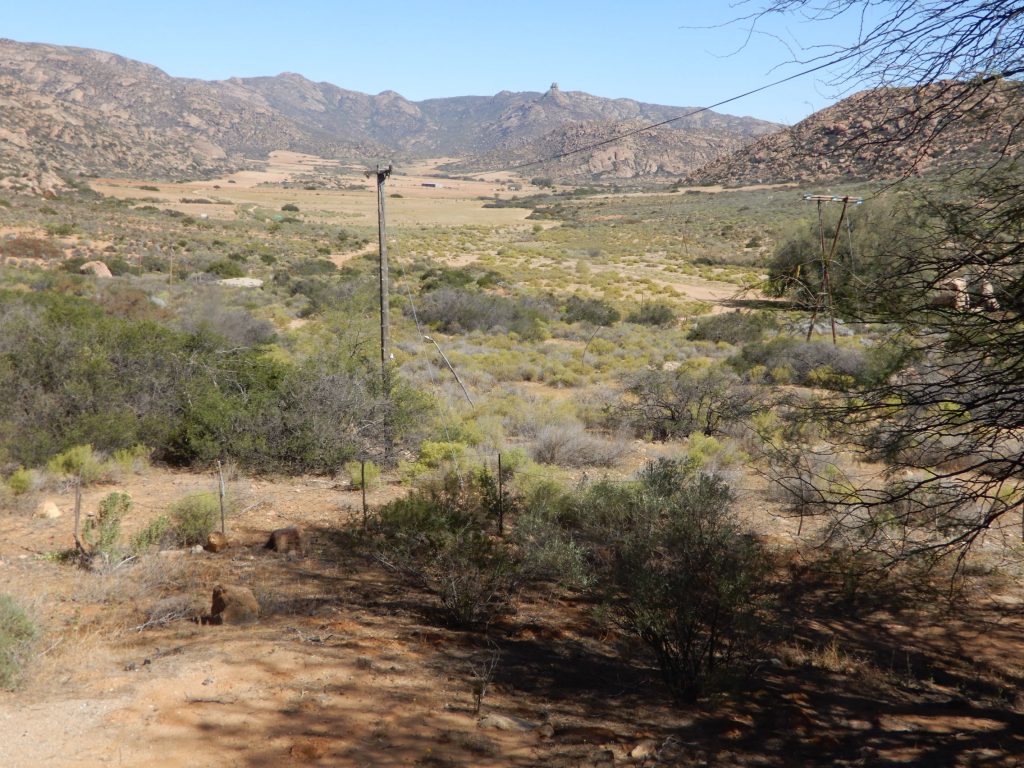
Amazingly, Uncle Mark managed to make contact with the current owner Jacoba Swart, and we were able to visit the house and even took her out to dinner. The house is now isolated at the end of a long road up the valley, but according to Koba, the old Post Road to Bowesdorp from Garies went straight on past the farmhouse and over the nek down into Bowesdorp, and hence the old telegraph poles still follow this route rather than the new N7 main road. Oom Hannes Genis remembers the road being just about still usable with a horse and cart in the 40’s. It is now a forgotten track.
Why did the farm end up with Sannie and not the sons? Abraham took a mortgage on his 1/20th portion of the farm Koets in 1907. In 1909 the larger farm was formally and officially subdivided amongst the children of Gerrit van Wyk and in 1910 the mortgage was transferred to the actual smaller subdivided farm Groot Gaas (as opposed to the theoretical “share”). When AEJC died in 1911, his widow Hendrina Johanna Wilhelmina Goosen van Wyk took on the mortgage but by 1928 couldn’t pay the capital sum when it fell due and was forced to sell. She explains in a statement to the Master of the Supreme Court (who was checking up on the administration of the estate) that the will of Gerrit van Wyk required the farm to be sold to one of his descendants. And thus it was bought by his grandson Johannes Jacobus Baptesta van Wyk, the son of the younger Gert van Wyk and Ouma Tollie (and the brother of Helena Maria Gloudina van Wyk Gillman).
Abraham Erasmus JC’s eldest son Gerrit farmed Ellenboogsfontein (aka Nieweplaats) which is to the west of Kamieskroon. Could this have been part of the original Koets? His will also dates the subdivision to 1909. On the map above you can see that Nieweplaats and Koets form a roughly circular or diamond shape together, and it does appear they were split down the middle.
Gerrit Van Wyk (1839-1914) took the portion where Kamieskroon is today. After the death of his first wife Janetta Susanna Debora Kotze he remarried Charlotte Maria Margaretha van der Westhuizen in 1876 (They, you will recall, were the in-laws of William John Gillman). She was the “famous” Ouma Tollie – the “widow Charlotte van Wyk” – who the local history books tell us sold part of Koets to the Bowesdorp Town Elders in order to build Kamieskroon on the land, around 1922. Charlotte Street in Kamieskroon is named after her. After the sale to the town elders, Charlotte’s son still owned a portion on the south side of the town – and apparently annoyed the townspeople by claiming rights to drive his flocks through the town streets! (We assume this was the Johannes Jacobus Baptesta who bought Groot Gaas).
Klein Gaas (later called Windhoek) and Haas Rivier (all part of the original farm Koets) had been passed to Gerrit’s daughter Maria Gloudina on her marriage into the Genis family (and ultimately a portion came to Joseph Gillman through his wife Minnie Genis). They remain with the Genis descendants to this day. Mark Gillman made contact with the current descendant on Windhoek – though he is now retired and his son runs the farm. Mark also arranged for us to visit the 90 year old Hannes Genis (at his old age home in Picketberg), the only son of 9 children who grew up on Haas Rivier with 8 sisters and is my great Aunt Minnie’s youngest brother.
Despite having a wonderful week visiting all the places in Namaqualand with family connections, Uncle Mark and I made no real progress on confirming who Sannie’s parents were. The only definite clue was Oom Hannes Genis saying he thought Lettie Joyce was her sister.
Lettie Joyce was Johanna Aletta Van Wyk (born 1893) the youngest daughter of the Abraham EJC van Wyk Senior who died in 1911. She worked in the Bowesdorp Hotel and married a police constable from Bowesdorp called Hugh Edward Joyce on 5th December 1921. From a book of Bowesdorp reminiscences by Abe Shapera that Mark found and gave me we know she lived on Groot Gaas at that time, presumably with her widowed mother. Aletta is on her father’s death notice – but not Susannah. Was Oom Hannes wrong?
Then in the Cape Archives I found William John’s divorce petition which stated that in 1912 his wife “returned to her parents residing on Groot Gaas where she has been living ever since” (dated 1917). Of course AEJC Snr died in 1911, so was this proof that her father was AEJC junior?
On my return home, I tried again on-line. I discovered all the records of the NG church have been scanned, but not all have been indexed. The unindexed scans don’t come up in searches. But you can page through them like a book. So I started going through page by page. And before too long found this:


Cornelis Albertus Arnoldus van der Westhuizen (1858- 1909) born on Ellenboogsfontein married Jeanetta Debora van Niekerk (1864-1925) in Bowesdorp. They farmed on Grootvallei. (My guess is this is Charlotta’s brother). Janetta’s brother was Izak Jacobus Marthinus van Niekerk (1859 – 1934) married to Aletta Elizabeth van Niewkerk. The Agenbags and Stones were other local farming families. Willem Jacobus van Wyk was Susanna’s half brother, and his wife was Aletta Mostert
So what is going on? This is NOT our Ouma Gaas’s birthdate (given as 7 Aug 1886 on her grave). But it is really close. And here is proof that AEJC van Wyk snr and his 2nd wife Hendrina Johanna Wilhelmina Goosen DID have a daughter named Susannah Johanna and this daughter ISN’T on his Death Notice. And she was baptised within 9 months of the date we have for Ouma Gaas’ birth.
Could the date of birth be wrong in the register? On her final marriage certificate her birth is given as 7 August 1887 – yet another variant. My grandfather Charles (Sannie’s son) always complained that the government recorded his birth in 1908 as 5th May, while he always celebrated on 5th March – a mistake had been made when recording his birth. So mistakes do happen. Her grave marker would have been commissioned by her daughter my Great Aunt Gladys, so that must have been the date the family celebrated. The most likely explanation is that the doopregister simply gets it wrong, and the family never got to see the entry. It would have been written up later and the Register carried around with the itinerant minister (he wasn’t based in Bowesdorp at the time but moved around continuously). She was baptized at the same ceremony as her cousin – Charlotte’s son Cornelis, so perhaps her baptism was delayed in order to share the same ceremony and party! Would the Dominee not have known the difference between a 3 month old baby and a nine month old baby though? The witnesses are her half-brother Willem and his wife Aletta.
Combined with the known and provable connection to Gaas, and Oom Hannes’s memory of the two sisters from Gaas, Sannie and Lettie, I think the proof is enough. Her omission from the death notice is strange but not unique and must be an oversight. Death Notices are incredibly useful but notoriously unreliable, as they are often completed by people assisting the family at a difficult time. I have since identified another child NOT on the Death Notice – Hendrik Jacobus born 31 January 1885 and baptized 22 March 1885. Now this could be the Hendrik Johannes already on the Death Notice, but the 2nd name misremembered – which would show it was done from memory and perhaps the widow signed in state of distress and didn’t check. When Sannie’s first husband William Gillman died, his second wife listed none of Sannie’s children on his death notice! So a death notice is not an absolute proof of anything.
So now we know her family – and these van Wyk’s are well documented in the genealogical records.
It
all begins with my 8th Great
grandfather: (by the way, the “sz” after the middle name is a patronymic –
ie is an abbreviation for “szoon” or “son of” – “Gerrit William’s son”)
a. Willem van Wijk born in Gelderland about 1655. His first
wife was Catharina Hillebrandts. Their son:
b. Gerrit Willemsz van Wijk born around 1738 married Elizabeth
Viviet in 1722. Their eldest son was:
c. Gerrit Gerritsz van Wijk born around 1723 married Martha
Smit. Their eldest son was:
d. Gerrit Gerritsz van Wijk born 1758 died 1835 married
Gesina Helena Botha. Their 3rd son was:
e. Abraham Erasmus van Wijk born 1885 married Martha Magdalena
Mouton. Their eldest son was:
f. Gerrit Johannes van Wijk born 1805 married Gesina Maria
Aggenbach. Their eldest son was:
g Abraham Erasmus Johannes Cornelis van Wijk born 1828 died
1911 – Sannie’s father.
So now we know who she is and where she came from. Let’s go back to her story.
After Helena died, William John inherited a pretty good estate that her parents had provided, and a year later he married her first cousin and neighbour, Sannie van Wyk.
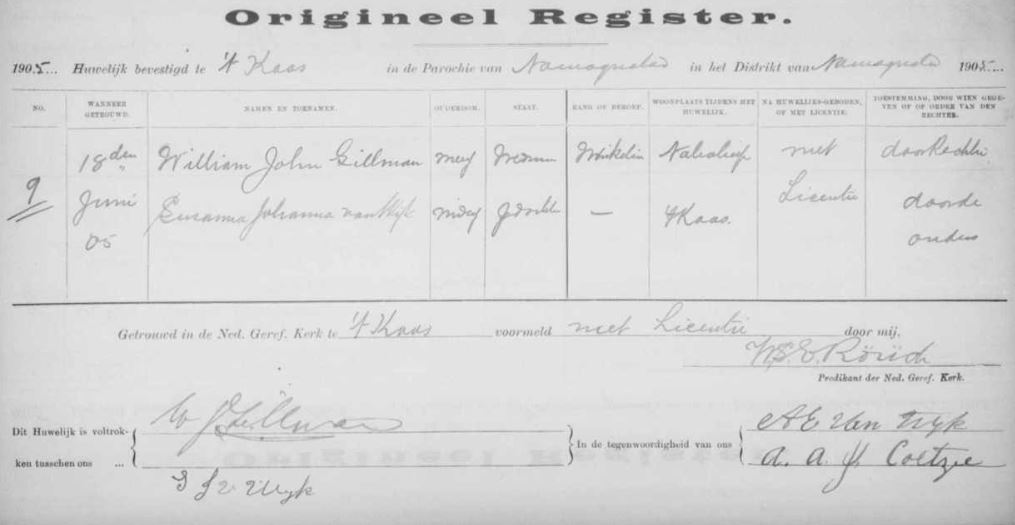
It seems from the Register that they were married on the farm Gaas itself (t’Kaas), and not in the church. By now William was Assistant Field Cornet for the Onder Kamiesberg area, a sort of honorary quasi-military/assistant magistrate/district commissioner role for the local government.
The divorce papers show they lived in Nababeep for six years and had four children: Aunty Gladys in 1906, my grandfather Charles Abraham in 1908, William Allen in 1909 and Uncle Abe (Abraham Erasmus) in 1911. She left William in 1912 when four weeks pregnant with uncle Josef. One can only speculate on the cause of the separation but Sannie took the infant Uncle Abe with her, leaving the other three with Grannie Gillman so that Abe and Josef were separated from their siblings for quite a while.
The three older children Gladys, Charles and William Allen remained with their grandmather Annie Gillman (born Wolstenholme) till her husband died in 1917 after which she moved to Cape Town with them and lived in some poverty until they were a bit older, when she returned to Namaqualand and they started work in their teens. (Her story deserves a book in itself).
Sannie must have gone to Cape Town about the same time as Annie. During the First World War, Namaqualand went into a deep recession with the effective closure of the Copper Mines during this period, along with severe droughts. Uncle Mark had traced a record of her as the mother of a Jacoba Gysberta Gillman (or Truter) and bizarrely the Cape Archives threw up a Jacobus Gysbertus Gillman born 22 January 1920 and died aged 4 months on 16 May 1920. Another mystery. Both names appear in different records but I can’t believe there were two children. There are baptisms in the NG church of a girl, naming the father as Jacobus Gysbertus Truter and (separately) fostering papers for a boy handing the child to her neighbour. There is also a Death Certificate for a girl, and a “Notice of Death under the Children’s Protection Act” for a boy. Some paperwork gives the surname Truter, some Gillman, but the mother on all paperwork is certainly Susanna Gillman. Both children are born and die on the same day as each other. I can understand twins being born on the same day but what is the chance of them dying on the same day 4 months later?! We have not traced any marriage with a Truter.
2nd husband: Angelo Frederick Faddel
Then just 18 months later in 1922 in Cape Town still she marries a recently widowed man Angelo Frederick Faddel with a bunch of young children. She lives with him at his home 28 Arnold St, Observatory until his death in 1937.
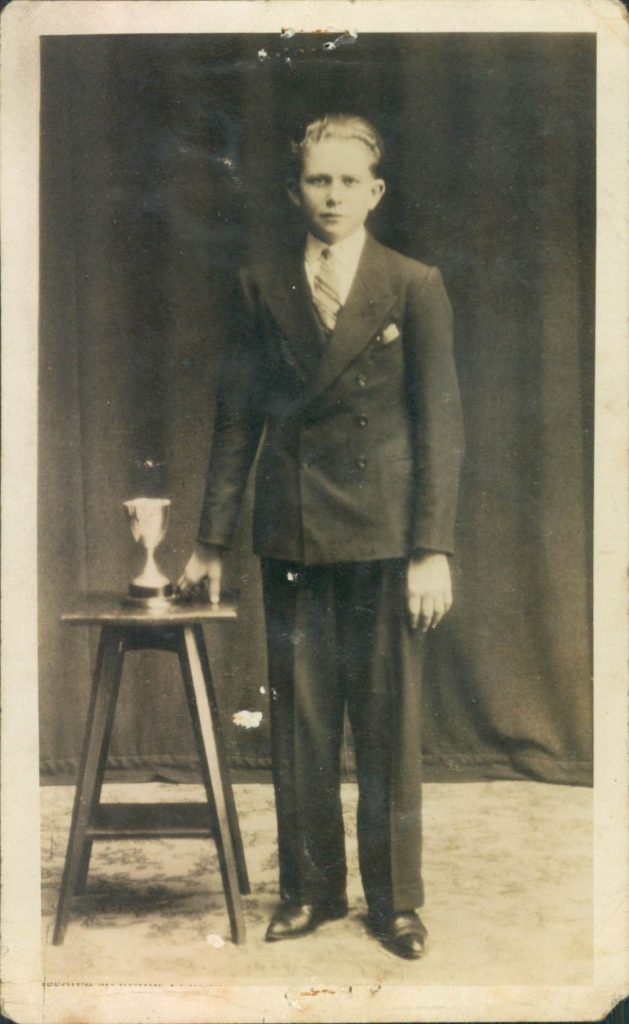
Willam John Gillman himself remarries in 1926 and has two further children. During this all this time we have to assume that uncle Josef and uncle Abe are with Sannie, and there are records of her daughter Gladys and son William Allen living at her address.
Tragically, her son William shoots himself age 22 at this address on 22 August 1932.
I know from personal conversations with my great aunt Gladys that they were very poor at this time and the Gillman children largely looked after themselves. Obviously Gladys remembered the suicide as a great shock.
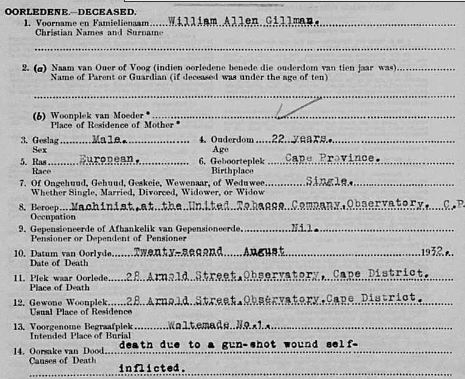
Mysteriously, Angelo Faddel then buys Groot Gaas in 1932. He was a train driver on the railways, and had a large family to support, and a house in Observatory to pay off. Where the cash came from we have no idea. There was a deep recession on in Namaqualand, so prices might have been low. But in 1936 he writes a will and leaves the farm to Sannie, and the house in Arnold Street to his children. Aunty Glady’s new husband Mick Stein is appointed Executor. Angelo dies a year later and Sannie moves to Groot Gaas.
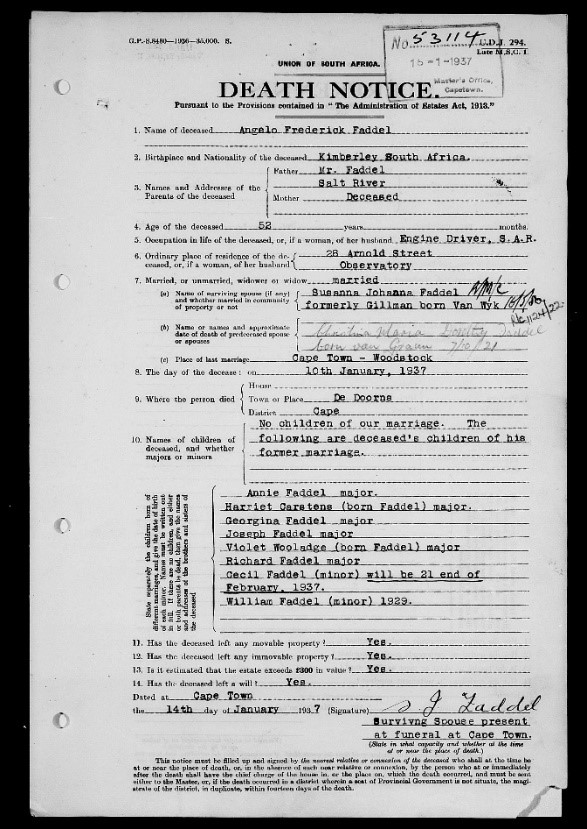
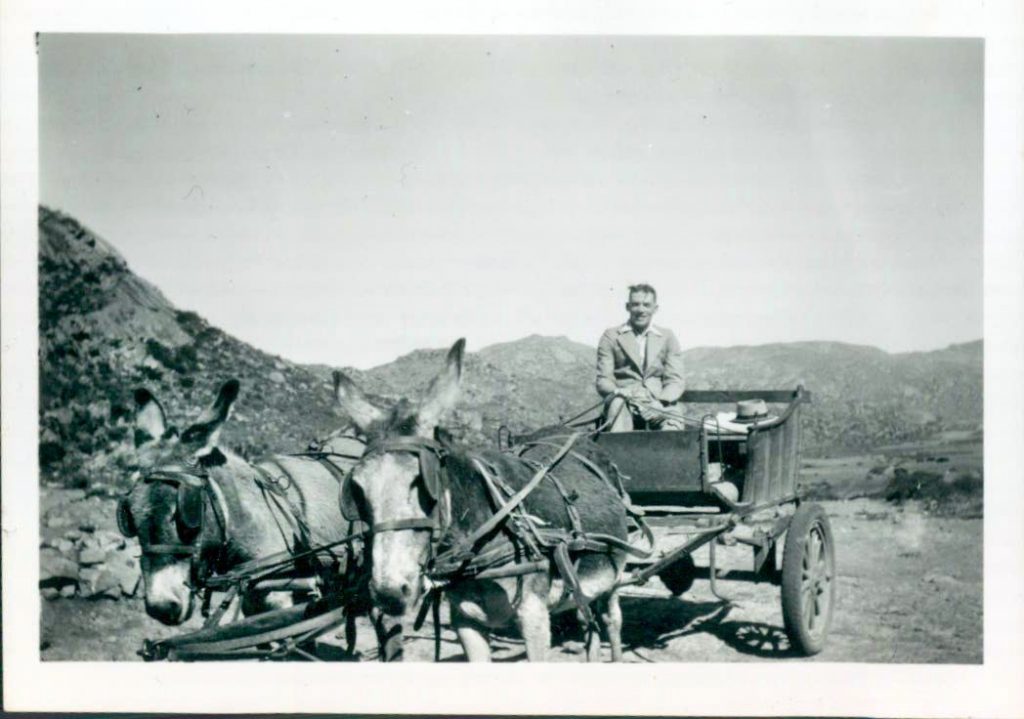
Meanwhile my grandfather Charles Abraham Gillman (Sannie’s eldest son) who had been in Cape Town since the First War, developed TB and was told to move somewhere drier. So he returned with his wife (Helene de Villiers, my Ouma) and baby daughter Anne to Namaqualand and in due course purchased a portion of his maternal grandfather’s farm Biesjesfontein outside Springbok. This (I discovered only in October 2019 through documents in the Cape Archives) had belonged since the 1860’s to John Wolstenholme, Annie Gillman’s father, and the farm became known as “Bloustasie” (or “Blaaustatie” in some records) from the trading post or shop made of blue-tinted zinc which he ran there alongside the road into Springbok. Documents from the time describe him as a Brewer, so I think the Bloustasie was famous not just for dry goods! Again we don’t know how my grandfather found the money for the purchase (it seems to have been owned by others in between, so we don’t believe it was inherited through his grandmother). But he raised his family of 7 there, and ran a herd of dairy cows and a dairy that served the whole area including Springbok. Grannie Annie Gillman came to live with the family along with two of her sisters and so was able to die aged 99 on the farm where she was born.
This is where Sannie comes into the memory of people still alive. First my mother and her siblings knew her from her visits to Bloustasie, where she came up by bus from Gaas. She was then known as Sannie Faddel and the children called her “Ouma Gaas” (the farm she was living on at the time) to distinguish her from Helene’s mother “Ouma Ladysmith”.
Sannie seems to have moved from the farm to Kamieskroon town in the late 1940’s. Oom Hannes Genis from Haas Rivier, remembers her just after the 2nd War living in a house in Kamieskroon, and he stayed with her while attending confirmation classes. We don’t know if the farm was sold or let out at the time. Old man Genis remembers an unmarried brother living on and working the farm.
3rd husband: David Josephus Strauss
In 1950 she seems to have been living in Lutzville when she married David Josephus Strauss a widower from Vanrynsdorp. This barely lasted a year, and she was again divorced, living in Nababeep we assume with her son Josef who was by then living there and working for the copper mines, married to Minnie Genis.
4th husband: Another van Wyk
Then comes her final marriage in 1953 to “Gerhard Johannes van Wyk” born 16 September 1885, a foreman on the mines in Pella.
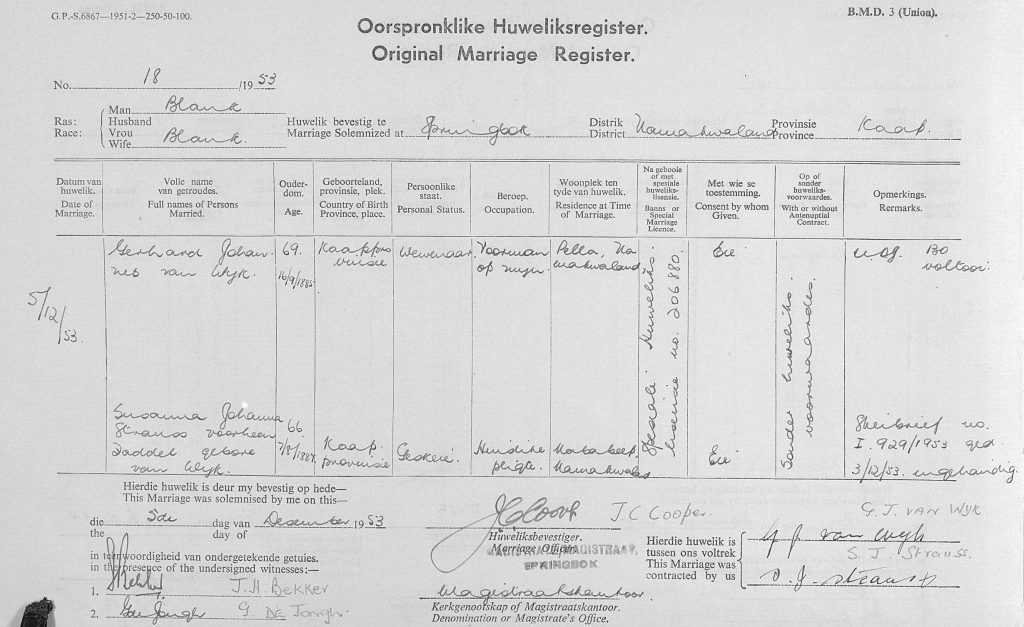
Who was this man? Was he related? In researching this I came across a startling coincidence:
Sannie’s eldest half-brother (Abraham’s son by his first wife Lotte Gagiano) was Gerrit Johannes van Wyk – born 37 years before Sannie in 1849. He married Johanna Christina Gloudina van Niekerk. Their 5th child was Gerrit Johannes van Wyk born 16 September 1885, baptised 24th January 1886. Born exactly the same day, month and year as Sannie’s last husband. The Gerrit in this baptism entry was the therefore her half-nephew:

What are the statistical chances of two people in the same region with the same name sharing the same exact day, month and year of birth? (Name spellings at this time could be all over the place – often formal Dutch forms were used in church records eg for this name “Gerhardus” but more informal forms were used in real life like Gerrit, Gerhard and even Gert. The same name could be, for example, Gloudina, Glaudina, Glodiena – and all in official documents for the same person). Actually this coincidence is not as unlikely as one might think, as Gerrit Johannes was a common name in the van Wyk clan. But nonetheless, more research is needed to sort this one out!
I don’t know when Gerhard van Wyk died, but sometime in the 1970’s Ouma Gaas returned to Cape Town to live her final years with her daughter Gladys. And it was Gladys who arranged her return to Kamieskroon for burial … in the back of a station wagon borrowed from Uncle Mark, and driven by her son and grandson (Uncle Abe and Norman) while Uncle Mark, Dawn, Charles and Jane followed on behind. The Station wagon broke down en route, coffin in the back and all! A dramatic life, even after death!
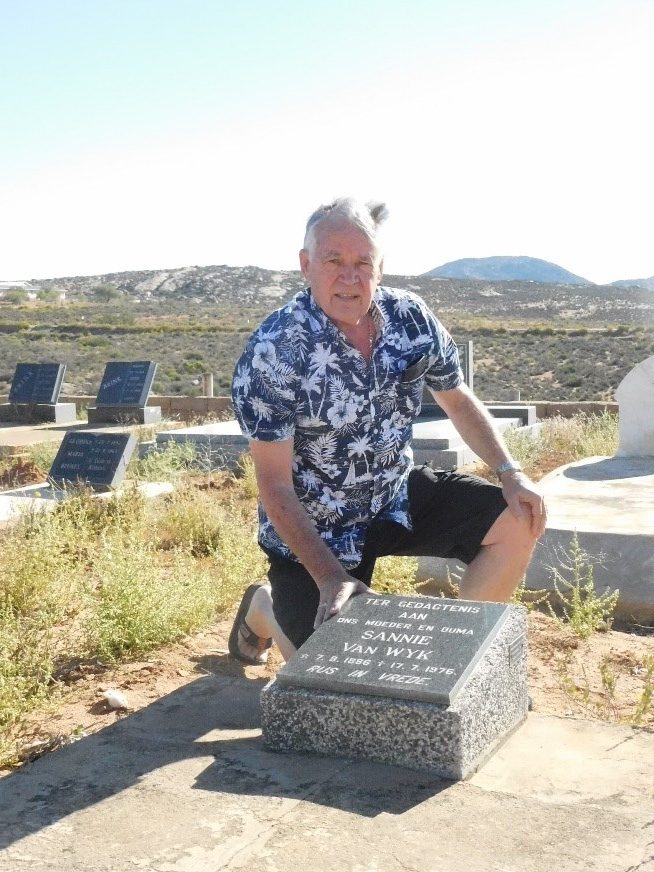
Next instalments to be written up:
The
Gillmans of Kalk Bay.
The Wolstenholmes of Biesjesfontein
